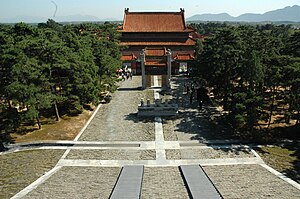Eastern Qing Tombs
| Imperial Tombs of the Ming and Qing Dynasties | |
|---|---|
| Name as inscribed on the World Heritage List | |
 |
|
| Location | China |
| Type | Cultural |
| Criteria | i, ii, iii, iv, vi |
| Reference | 1004 |
| UNESCO region | Asia-Pacific |
| Coordinates | 40°11′09″N 117°38′49″E / 40.185783°N 117.646923°ECoordinates: 40°11′09″N 117°38′49″E / 40.185783°N 117.646923°E |
| Inscription history | |
| Inscription | 2000 (24th Session) |
| Extensions | 2003; 2004 |
The Eastern Qing tombs (Chinese: ; pinyin: ) are an imperial mausoleum complex of the Qing dynasty located in Zunhua, 125 kilometres (78 mi) northeast of Beijing. They are the largest, most complete, and best preserved extant mausoleum complex in China. Altogether, five emperors: (Shunzhi, Kangxi, Qianlong, Xianfeng, and Tongzhi), 15 empresses, 136 imperial concubines, three princes, and two princesses of the Qing dynasty are buried here. Surrounded by Changrui Mountain, Jinxing Mountain, Huanghua Mountain, and Yingfei Daoyang Mountain, the tomb complex stretches over a total area of 80 square kilometres (31 sq mi).
At the center of the Eastern Qing tombs lies Xiaoling, the tomb of the Shunzhi Emperor (1638–1661), who became the first Qing emperor to rule over China. Shunzhi was also the first emperor to be buried in the area. Buried with him are his empresses Xiaokangzhang (mother of the Kangxi Emperor) and Consort Donggo. The major tombs to the east of Shunzhi's mausoleum are Jingling (Kangxi Emperor) and Huiling (Tongzhi Emperor). To the west lie Yuling (Qianlong Emperor), Ding Dongling (Dowager Empress Cixi and Empress Ci'an), and Dingling (Xianfeng Emperor).
All imperial mausolea at the Eastern Qing tombs follow a pattern established by the Xiaoling mausoleum of the Shunzhi Emperor. The basic layout consists of three sections: spirit way, palaces, and offering kitchens. Xiaoling has the most elaborate spirit way and contains the following structures (from south to north): a stone archway, eastern and western dismounting stelae, grand palace gate, hall for changing clothes, divine merit stelae pavilion, stone sculptures, dragon-and-phoenix gate, one-arch bridge, seven-arch bridge, five-arch bridge, eastern and western dismounting stelae, three-way three-arch bridges and flat bridge. The palace section of Xiaoling contains the following structures (from south to north): spirit way stela pavilion, eastern and western halls for court officials, Long'en Gate, eastern and western sacrificial burners, eastern and western side halls, Long'en Hall (Chinese: ; pinyin: ; literally: "Hall of Enormous Grace"), gate of the burial chamber, two-pillar gate, stone altar-pieces, square city, memorial tower, glazed screen, crescent city, precious citadel, earth mound with the underground palace underneath. The north of the palace was closed off with walls. The section of the offering kitchens was positioned to the left of the palace section, it consists of a walled compound that contains the offering kitchens proper (i.e., where the sacrificial food was cooked), the southern and northern offering warehouses, and a slaughterhouse where the oxen and sheep were butchered.
...
Wikipedia
